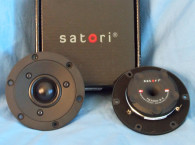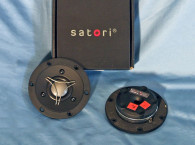




This month, SB Acoustics sent Voice Coil its second high-end 29 mm beryllium diaphragm neodymium dome, the SB29BNC-C000-4 (see Photo 1). Features for this transducer include a small format 72 mm diameter injection-molded plastic faceplate, an 8 mm wide coated cloth surround, a 29 mm beryllium diaphragm, a copper cap on pole piece for reduced voice coil inductance and minimum phase shift, internal pressure equalization and flow resistor for non-resonant coupling of cavities, copper-clad aluminum wound voice coil wire, 0.25 mm Xmax, 95 dB sensitivity, a foam-mounting gasket, and gold-plated terminals.
Testing commenced using the LinearX LMS analyzer to produce the 300-point impedance sweep illustrated in Figure 1. The magnetic fluid damped resonance occurs at a moderately 919.7 Hz. With a 2.9 Ω DCR (Re), the minimum impedance for this tweeter is 3.16 Ω at 3.58 kHz. Following the impedance test, I recess-mounted the SB tweeter in an enclosure that had a baffle area of 17” × 8” and measured the on- and off-axis frequency response again using the Loudsoft FINE R+D analyzer (courtesy of Loudsoft) and the GRAS 46BE 1/4” were set up to measure the 200 Hz to 40 kHz frequency response (using a 192 kHz sampling rate) at 2 V/0.5 m normalized to 2.83 V/1m. Data was then acquired with sweeps at 0°, 15°, 30°, and 45°. Figure 2 shows the on-axis response of the SB29BNC-C000-4, which measured ±2 dB from 2.0 kHz to 26.1 kHz, with the beryllium breakup mode at peaking at about 38 kHz.
Figure 3 gives the on- and off-axis response of the SB29BNC-C000-4 beryllium tweeter. Figure 4 shows the off-axis curves normalized to the on-axis response. Figure 5 shows the CLIO 180° polar plot (measured in 10° increments with 1/3 octave smoothing). The two-sample SPL comparison is illustrated in Figure 6, indicating the two samples were closely matched to within slightly less than 1 dB throughout its operating range.




For the next test procedure, I again initialized the Listen SoundCheck AudioConnect analyzer along with the Listen SCM-2 1/4” microphone to measure the impulse response with the tweeter recess-mounted on the same test baffle. Importing this data into the Listen SoundMap software produced the CSD waterfall plot given in Figure 7. Figure 8 shows the STFT displayed as a surface plot.
For the last SoundCheck test protocol, I set the 1 m SPL to 94 dB (2.55 V), using a noise stimulus and built in SLM, and measured the second and third harmonic distortion with the microphone placed 10 cm from the dome diaphragm (see Figure 9).

All things taken together, and since I know that Frank and Ulrik (Danesian Audio) spend a lot of time listening to various iterations of a driver as they go through the development process, I’m guessing that this is a very fine sounding product.
For more information visit www.sbacoustics.com. VC
This article was published in Voice Coil, March 2019.







